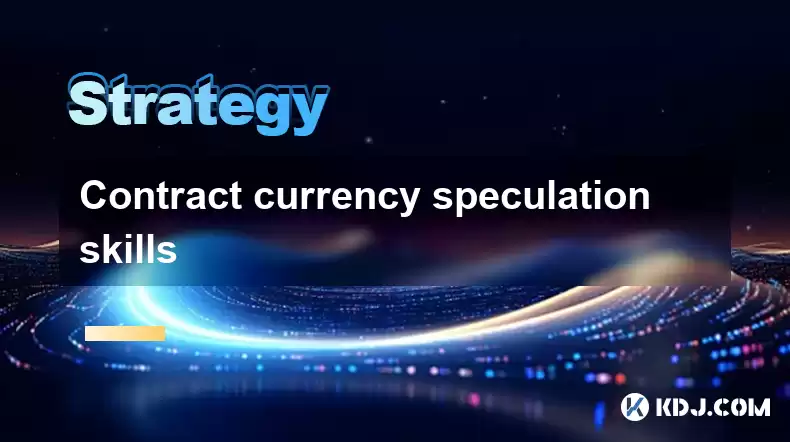-
 bitcoin
bitcoin $100977.009184 USD
-2.05% -
 ethereum
ethereum $3282.009150 USD
-3.23% -
 tether
tether $0.999813 USD
-0.02% -
 xrp
xrp $2.208254 USD
-4.89% -
 bnb
bnb $951.411089 USD
0.55% -
 solana
solana $155.761205 USD
-2.84% -
 usd-coin
usd-coin $1.000217 USD
0.02% -
 tron
tron $0.284475 USD
-1.28% -
 dogecoin
dogecoin $0.162363 USD
-1.53% -
 cardano
cardano $0.533988 USD
-0.47% -
 hyperliquid
hyperliquid $39.174339 USD
-3.22% -
 chainlink
chainlink $14.724828 USD
-1.16% -
 bitcoin-cash
bitcoin-cash $477.297986 USD
-1.28% -
 zcash
zcash $554.227426 USD
17.30% -
 ethena-usde
ethena-usde $0.998995 USD
-0.03%
Contract currency speculation skills
Effective contract currency trading involves understanding contract currency mechanics, adopting market analysis strategies, implementing risk management, and leveraging advanced techniques to optimize profits while maintaining emotional control.
Jan 11, 2025 at 10:37 pm

- Understanding Contract Currency Basics
- Strategies for Market Analysis
- Risk Management and Trading Discipline
- Advanced Techniques for Optimizing Profits
- Emotional Control and Mindfulness in Trading
- Contract Currency Overview:
- Definition: A contract currency is a digital asset that derives its value from an underlying asset, such as a traditional currency (e.g., USD, EUR), a commodity (e.g., gold, oil), or another cryptocurrency.
- Types of Contract Currencies: Perpetual contracts, futures contracts, and options contracts are the most common types, each with unique characteristics and risk-reward profiles.
- Benefits of Contract Currency Trading: High potential returns, flexibility, and 24/7 market access.
- Trading Platforms and Order Types:
- Choosing a Trading Platform: Consider factors such as security, fees, trading tools, and customer support when selecting a platform.
- Order Types: Market orders, limit orders, and stop-loss orders are the main order types used in contract currency trading, each serving different purposes in market conditions.
- Leverage and Margin: Understand the concept of leverage and how it amplifies both profits and risks, and manage margin levels accordingly.
- Market Analysis and Technical Indicators:
- Market Analysis Methods: Conduct technical analysis using indicators like moving averages, Bollinger Bands, and relative strength index (RSI) to identify market trends and potential entry/exit points.
- Fundamental Analysis: Examine macroeconomic factors, news events, and sentiment analysis to gain a comprehensive understanding of market drivers.
- Trend Following Strategies:
- Identifying Trends: Use technical indicators to identify whether the market is trending up, down, or sideways.
- Trend-Following Techniques: Place orders in the direction of the trend, using stop-loss orders to protect against reversals.
- Position Sizing: Determine an appropriate position size based on the market volatility and your risk tolerance.
- Range Trading Strategies:
- Identifying Ranges: Identify market ranges where the price bounces between support and resistance levels.
- Range Trading Techniques: Buy near support levels and sell near resistance levels, taking advantage of price fluctuations within the range.
- Exit Strategies: Set profit targets and stop-loss orders to lock in gains and limit losses.
- Scalping Strategies:
- Scalping Overview: A short-term trading strategy that aims to capture small profits from frequent, small price movements.
- Scalping Techniques: Use fast indicators and tight spreads to identify and execute quick trades.
- Risk Management: Precise risk management is crucial in scalping, as even small losses can accumulate over time.
- Risk Management Strategies:
- Stop-Loss Orders: Use stop-loss orders to limit potential losses if the market moves against your position.
- Position Sizing: Calculate appropriate position sizes based on your risk tolerance and the underlying asset's volatility.
- Hedging Techniques: Explore hedging strategies, such as options or futures contracts, to reduce risk exposure.
- Trading Discipline and Psychology:
- Emotional Control: Manage emotions to avoid making impulsive or irrational trades.
- Patience and Discipline: Stick to your trading plan and avoid chasing losses or overtrading.
- Performance Evaluation: Regularly review your trades to identify areas for improvement and adjust your strategy accordingly.
- Trading Bots and Algorithmic Trading:
- Trading Bots: Use automated scripts to execute trades based on predefined parameters and indicators.
- Algorithmic Trading: Employ sophisticated algorithms to analyze vast amounts of market data and identify trading opportunities.
- Advantages and Limitations: Understand the potential advantages and challenges of using technology in trading.
- Copy Trading and Social Trading:
- Copy Trading: Copy the trades of experienced traders who have a proven track record.
- Social Trading: Engage with a community of traders, share ideas, and learn from others.
- Risks and Considerations: Be aware of the risks associated with relying on other traders' insights.
Q: What are the key differences between contract currencies and traditional currencies?A: Contract currencies are digital assets that represent the value of an underlying asset, while traditional currencies are fiat currencies issued and controlled by central banks.
Q: Which trading strategy is best suited for beginners?A: Trend following is a suitable strategy for beginners as it involves identifying and trading in the direction of the current market trend.
Q: How can I improve my risk management skills as a contract currency trader?A: Utilize stop-loss orders, position sizing based on risk tolerance, and consider hedging strategies to manage risk exposure.
Q: What advanced techniques can I use to enhance my trading performance?A: Explore trading bots and algorithmic trading for automated trading or use copy trading and social trading to leverage the insights of experienced traders.
Q: How can I develop the emotional control and discipline required for successful contract currency trading?A: Identify emotional triggers, practice mindfulness techniques, and continuously evaluate your trading performance to improve your psychological resilience.
Disclaimer:info@kdj.com
The information provided is not trading advice. kdj.com does not assume any responsibility for any investments made based on the information provided in this article. Cryptocurrencies are highly volatile and it is highly recommended that you invest with caution after thorough research!
If you believe that the content used on this website infringes your copyright, please contact us immediately (info@kdj.com) and we will delete it promptly.
- Vande Mataram at 150: Stamps, Coins, and a Year-Long Celebration
- 2025-11-07 14:45:01
- Pi Network: Alignment, Not Just Speed, Is the Future of Crypto
- 2025-11-07 13:00:02
- Pi Network: Life Changes and a New Era Dawns for Crypto Pioneers
- 2025-11-07 13:00:02
- Bonhams Hong Kong: Rare Watches Echo Through Time
- 2025-11-07 12:35:01
- Unverified Apps, PiCoin, and a Costly Lesson: Navigating the Wild West of Crypto
- 2025-11-07 13:05:01
- Fed Governors, FOMC, and Interest Rates: Navigating the Shifting Landscape
- 2025-11-07 13:05:01
Related knowledge

Navigating a crypto bear market: strategies for survival and profit.
Nov 05,2025 at 02:04pm
Navigating a Crypto Bear Market: Strategies for Survival and Profit Surviving a crypto bear market requires more than just patience—it demands strateg...

Ethereum gas fees explained: how to save money on your transactions.
Nov 04,2025 at 04:01pm
Ethereum Gas Fees: Understanding the Basics1. Ethereum operates on a decentralized network where every transaction requires computational power to exe...

Kraken margin trading explained: a complete guide to leveraging your positions.
Nov 04,2025 at 02:19pm
Kraken Margin Trading Overview1. Kraken is one of the most established cryptocurrency exchanges offering margin trading to experienced traders seeking...

NFT flipping for beginners: a step-by-step guide to profitable trading.
Nov 02,2025 at 11:54pm
NFT Flipping Basics: Understanding the Market1. NFT flipping involves purchasing non-fungible tokens at a lower price and reselling them for profit, o...

DeFi yield farming guide: maximizing returns on PancakeSwap and Uniswap.
Nov 05,2025 at 12:20am
Understanding Yield Farming on PancakeSwap and Uniswap1. Yield farming has become a central activity in the decentralized finance (DeFi) space, allowi...

How to find the next 100x altcoin: a fundamental analysis checklist.
Nov 02,2025 at 09:54pm
Decentralized Exchanges Are Reshaping Trading Dynamics1. Decentralized exchanges (DEXs) have emerged as a powerful alternative to centralized platform...

Navigating a crypto bear market: strategies for survival and profit.
Nov 05,2025 at 02:04pm
Navigating a Crypto Bear Market: Strategies for Survival and Profit Surviving a crypto bear market requires more than just patience—it demands strateg...

Ethereum gas fees explained: how to save money on your transactions.
Nov 04,2025 at 04:01pm
Ethereum Gas Fees: Understanding the Basics1. Ethereum operates on a decentralized network where every transaction requires computational power to exe...

Kraken margin trading explained: a complete guide to leveraging your positions.
Nov 04,2025 at 02:19pm
Kraken Margin Trading Overview1. Kraken is one of the most established cryptocurrency exchanges offering margin trading to experienced traders seeking...

NFT flipping for beginners: a step-by-step guide to profitable trading.
Nov 02,2025 at 11:54pm
NFT Flipping Basics: Understanding the Market1. NFT flipping involves purchasing non-fungible tokens at a lower price and reselling them for profit, o...

DeFi yield farming guide: maximizing returns on PancakeSwap and Uniswap.
Nov 05,2025 at 12:20am
Understanding Yield Farming on PancakeSwap and Uniswap1. Yield farming has become a central activity in the decentralized finance (DeFi) space, allowi...

How to find the next 100x altcoin: a fundamental analysis checklist.
Nov 02,2025 at 09:54pm
Decentralized Exchanges Are Reshaping Trading Dynamics1. Decentralized exchanges (DEXs) have emerged as a powerful alternative to centralized platform...
See all articles










































































